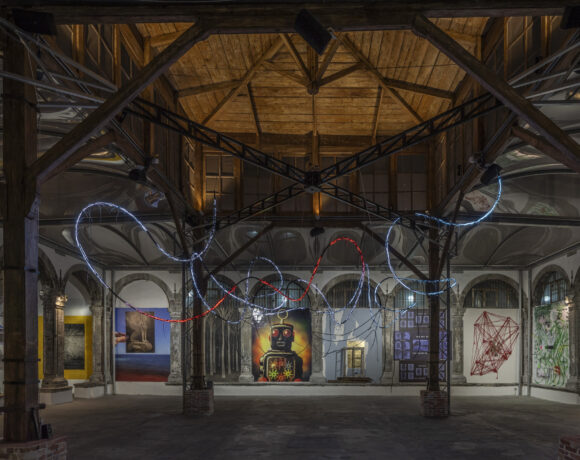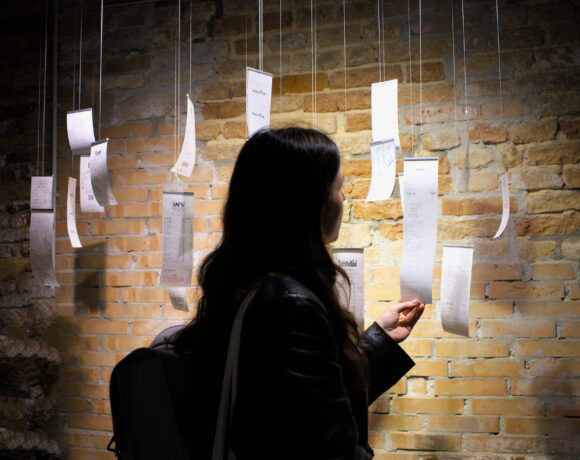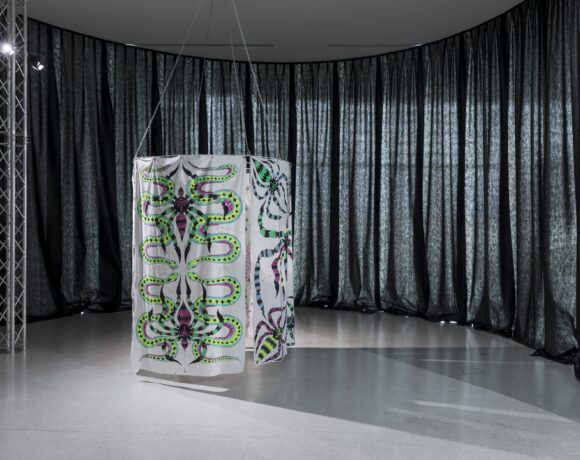Symbolically inaugurated on November 25th, on the occasion of the World Day for the Elimination of Violence against Women, Qatra Qatra. Goccia a goccia is much more than a reaction on the events of recent months, which have seen Kabul and Afghanistan precipitously fall into the hands of the Taliban. The exhibition curated by Amanullah Mojadidi, a Paris-based curator and artist of Afghan origin, traces the events in his country with artists Lida Abdul, Hangama Amiri, Rada Akbar, Kubra Khademi and Mario García Torres, and represents the continuation of a journey that for the curator began in 2013 with the birth of his collaboration with Imago Mundi Foundation and the creation of Imago Mundi Collection Afghanistan.
“Qatra qatra darya mehsha” (Drop by drop a river is formed) is an ancient Afghan proverb that invites to have hope, patience and determination, and that represents in this case the maṇḍala of strength and courage of the four Afghan activists present in the exhibition, who have made the fight against discrimination their artistic mission.
In addition to some works part of Imago Mundi Collection Afghanistan made in 2013, on show there are works by Kubra Khademi (1989), a feminist and refugee currently living in Paris, who after staging an extremely provocative performance in the streets of Kabul to denounce the harassment daily suffered by Afghan women, was forced to flee death threats in 2015, thanks to the help of UNESCO. In Ordinary Women and the diptych The Warm War, Khademi turns her gaze to the myths and heroic stories she was told as a child, whose protagonists – religious figures and prophets – undergo a feminising metamorphosis, a reinterpretation and rewrite the historical patriarchal tradition. Female Crimes aims to draw attention to the misogynistic and male chauvinist culture that blames women for what are considered heinous female crimes and for which women can be imprisoned: inside the openings of the old cells of the “Prison Galleries” – part of the original structure of the old Hapsburg prisons now used as an exhibition space – we find drawings that represent the sexual power of women oppressed by Afghan society.
The work of video-maker Lida Abdul (1973) – who fled Afghanistan in 1979 after the Soviet invasion and took refuge in India, Germany and finally the United States – focuses on denouncing the devastation of war, migration, the relationship between the identity of bodies and architecture; her short film White House emphasises, through the action of the white brush, how it is impossible to reconstruct what has been destroyed and definitively lost, such as the Past. In Transit suggests a reflection on the consequences of war: the carcass of a Soviet war plane becomes in the play of some children a fantastic fallen bird.
Hangama Amiri (1989) fled her country in 1990, after the Taliban took power, and studied painting and printmaking at Yale in the United States. Amiri, who has recently turned to weaving, presents in this exhibition Mariam Beauty Salon and Journalist, works that, through the Afghan textile tradition, aim to reflect on the macho and ultra-conservative norms that limit the standards of female appearance, calling for greater concealment of women and their beauty.
Activist, curator and conceptual artist, Rada Akbar (1988) is the author of the photographic series Invisible Captivity, in which the women depicted are under total Taliban control, both physical and mental, claimed as property (marked by fingerprints) and prisoners of a mentality with intangible barriers.
The exhibition concludes with the film Tea by Mario Garcia Torres (1975), a study of the life and work of the artist Alighiero Boetti (1940-1994), who in the 1970s lived in Kabul in his famous studio and hotel “One Hotel”, a popular stop on the hippies’ itinerary between East and West. An authentic nostalgic reflection that compares Boetti’s 1970s Kabul with the author’s 2000s Kabul.
In the succession of the various works on show, the exhibition highlights complex aspects of Afghanistan, a country where the situation of women appears precarious and unfair from many points of view, but whose artists do not lose strength and dedication to the cause, thirsting for a single, fundamental right: freedom.
Paola Natalia Pepa
Info:
Qatra Qatra. Goccia a goccia
curated by Amanullah Mojadidi
25/11/2021 – 09/01/2022
Fondazione Imago Mundi
Gallerie delle Prigioni, Piazza Duomo 20, Treviso
Free entry
info@fondazioneimagomundi.org
www.fondazioneimagomundi.org
 Kubra Khademi, Ordinary Women #14, 2020, courtesy of the artist and Galerie Eric Mouchet
Kubra Khademi, Ordinary Women #14, 2020, courtesy of the artist and Galerie Eric Mouchet
 Lida Abdul, White House, 2005, video still, courtesy of the artist and Galleria Giorgio Persano
Lida Abdul, White House, 2005, video still, courtesy of the artist and Galleria Giorgio Persano
 Rada Akbar, Invisible Captivity, 2013, photo credit Marco Pavan, courtesy Fondazione Imago Mundi
Rada Akbar, Invisible Captivity, 2013, photo credit Marco Pavan, courtesy Fondazione Imago Mundi
Independent curator specialized in Argentine art, with studies and publications on the subject (“Argentina at the Venice Biennale of Art” in Storie della Biennale di Venezia, Ed. Ca’ Foscari, 2020), founder in 2014 of arteargentina.it, the first Italian platform dedicated to Argentine art in Italy. She currently collaborates in Venice with galleries and artists.






NO COMMENT